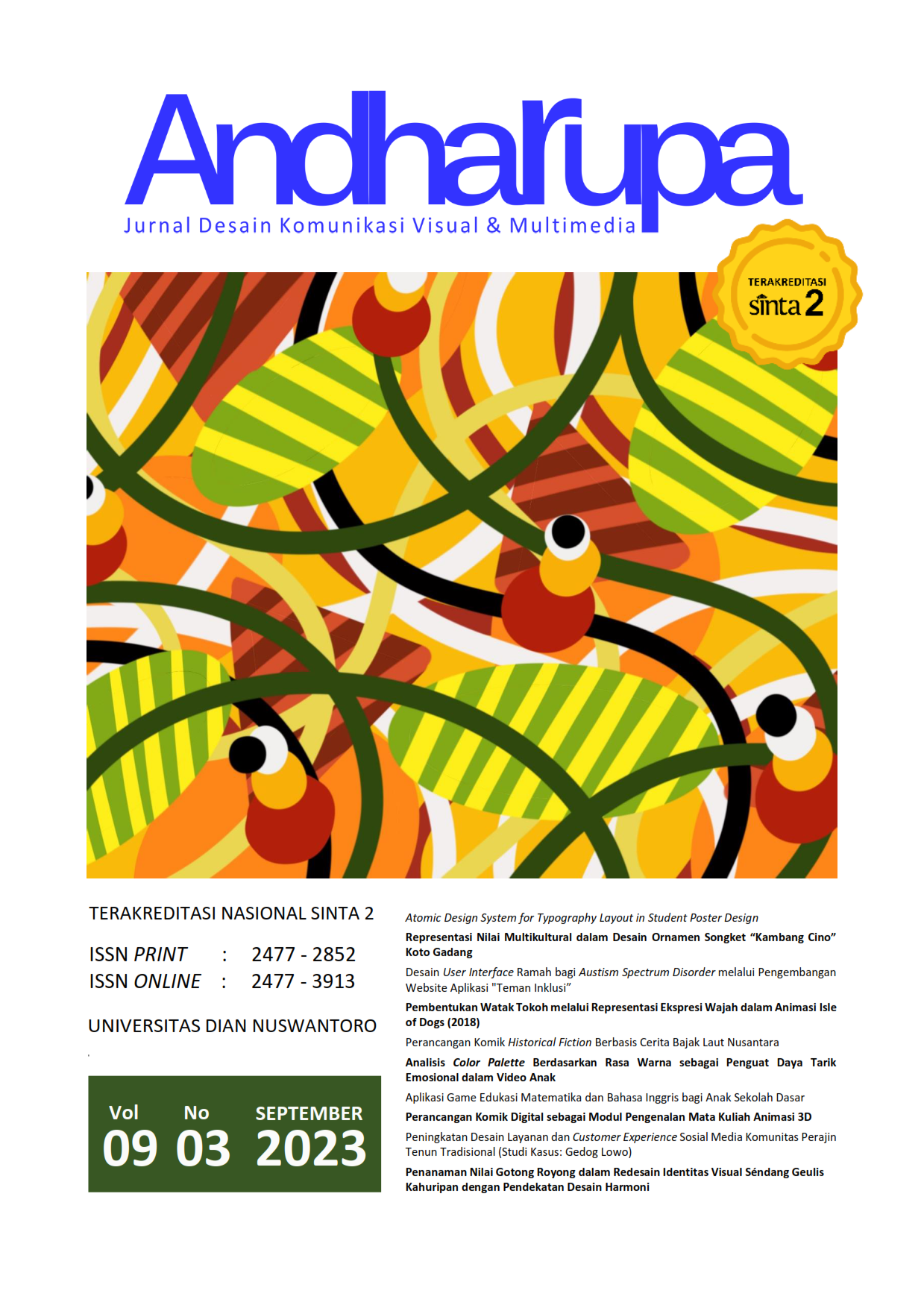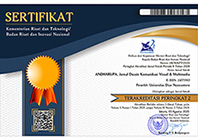Pembentukan Watak Tokoh melalui Representasi Ekspresi Wajah dalam Animasi Isle Of Dogs (2018)
DOI:
https://doi.org/10.33633/andharupa.v9i03.4693Abstract
Abstrak Ekspresi wajah merupakan elemen yang berperan besar dalam menghidupkan karakter animasi. Dengan ekspresi wajah, animasi mampu menyampaikan perasaan dan pemikiran dari karakternya sehingga menghadirkan watak yang lebih kuat. Adanya dualitas pada tokoh manusia dan tokoh anjing di film animasi “Isle of Dogs” (2018) menarik untuk dikaji karena ekspresi wajah pada anjing dan perwatakannya yang lebih humanis membuatnya terkesan lebih hidup dibandingkan dengan tokoh manusia. Analisis dilakukan untuk mengetahui penggunaan ekspresi wajah terhadap pembentukan watak tokoh anjing dan manusia dalam film animasi “Isle of Dogs” (2018). Tokoh yang dikaji yaitu tokoh Chief dan tokoh Mayor Kobayashi. Data diambil melalui observasi lalu dianalisis dengan metode analisis visual menggunakan teori ekspresi wajah dan teori Believability. Ditemukan bahwa meskipun memiliki fitur wajah yang menonjol, penggunaan ekspresi wajah yang minim oleh tokoh Mayor Kobayashi menyebabkan keterbatasan untuk memahami emosi dan pola pikirnya. Watak yang dapat dibentuk menjadi terbatis, mengakibatkan kesan karakter yang kaku dan dangkal. Tokoh Chief lebih ekspresif dengan emosi yang beragam, sehingga karakterisasinya pun lebih humanis dan terbentuk perkembangan watak yang dinamis. Penggunaan ekspresi wajah yang menonjol juga memudahkan penonton untuk menerima pesan emosi dari tokoh, menjadikan tokoh believable. Kata Kunci: animasi stop-motion, ekspresi wajah, emosi, karakter, tokoh animasi AbstractFacial expressions are a significant role element in bringing animated characters to life. With facial expressions, the animation can convey the feelings and thoughts of the characters to present a stronger characteristic. The existence of duality in human and dog characters in the animated film "Isle of Dogs" (2018) is interesting to study since the facial expressions of dogs and their more humane demeanor make them seem livelier than human characters. The analysis was carried out to discover the use of facial expressions in shaping dog and human characters in the animated film "Isle of Dogs" (2018). The figures studied are the Chief and Major Kobayashi figures. The data was taken through observation and then analyzed by visual analysis using the facial expressions and Believability theory. It was discovered that even though he has prominent facial features, the use of minimal facial expressions by the character Major Kobayashi causes limitations in understanding his emotions and thought patterns. The available formed characters are limited, making an impression of a rigid and shallow character. Chief's character is more expressive and has various emotions so his characterization is more humane and creates a dynamic character development. The use of prominent facial expressions also makes it easier for the audience to receive emotional messages from the characters, making the characters believable. Keywords: animation character, character, emotion, facial expression, stop-motion animationReferences
Bates, J. (1994). The Role of Emotion in Believable Agents. Communications of the ACM, 37(7).
Lee, M., & Heeter, C. (2010). What Do You Mean by Believable Characters: The Effect of The Character Newness, Rating and Evilness on The Perception of The Character Believability. In Igarss 2014 (Issue 1).
Maselli, V. (2018). The Evolution of Stop-motion Animation Technique Through 120 Years of Technological Innovations. International Journal of Literature and Arts, 6(3).
Matsumoto, D., & Ekman, P. (2008). Facial expression analysis. Scholarpedia, 3(5).
Nässi, A.-K. (2014). The Production Process of the Stop Motion Animation: Dear Bear [Bachelor’s thesis]. Tampere University of Applied Science.
Osipa, J. (2008). Stop Staring: Facial Modeling and Animation Done Right, 2nd Edition (2nd ed.). Wiley India Pvt.
Pikkov, Ü. (2010). Animasophy: Theoretical Writings on the Animated Film. Estonian Academy of Arts.
Priebe, K. a. (2010). The advanced art of Stop-Motion Animation (1st Ed). Cengage Learning PTR.
Roberts, S. (2011). Character Animation Fundamentals: Developing Skills for 2D and 3D Character Animation. Elsevier Ltd.
Selby, A. (2013). Animation. Laurence King Publishing.
Wilford, L., & Stevenson, R. (2018). The Wes Anderson Collection: Isle of Dogs. Abrams.
Windayanti, R. R., & Suwono. (2014). Facial Expressions and Gestures of Body Language Analysis of The Male Main Character Jack Mccall in A Thousand Words Film 2012. English Language and Literature Journal, 1(1).
Zenit, A. R. (2017). Penokohan Tokoh Utama Anime Sakurasou No Pet Na Kanojo. Jurnal Program Studi Sastra Jepang, 6(1).
Zong, M., Qi, Z., & Zong, Z. (2020, March 31). Research on Character Expression Shaping in Animation Movies.
Downloads
Published
Issue
Section
License
Authors who publish with this journal agree to the following terms:
- Authors retain copyright and grant the journal right of first publication with the work simultaneously licensed under a Creative Commons Attribution License that allows others to share the work with an acknowledgment of the work's authorship and initial publication in this journal.
- Authors are able to enter into separate, additional contractual arrangements for the non-exclusive distribution of the journal's published version of the work (e.g., post it to an institutional repository or publish it in a book), with an acknowledgment of its initial publication in this journal.
- Authors are permitted and encouraged to post their work online (e.g., in institutional repositories or on their website) prior to and during the submission process, as it can lead to productive exchanges, as well as earlier and greater citation of published work (See The Effect of Open Access).















